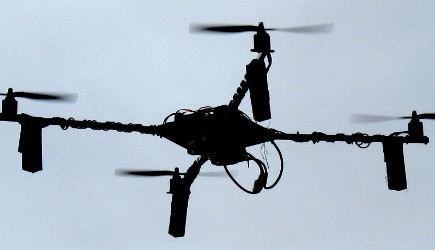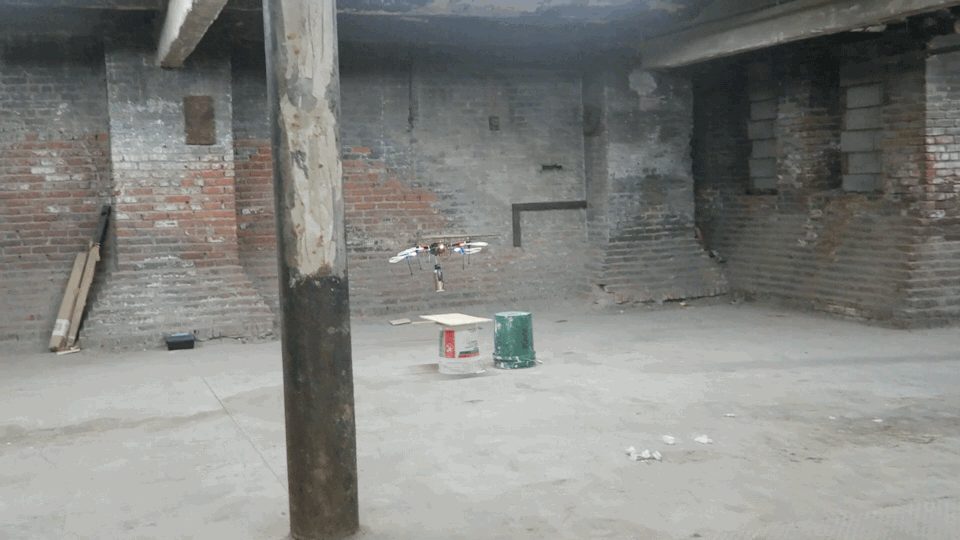Things To Do With Drones
June 18, 2015
on
on

Of First Person View drone racing and building indoor spray painting quadcopters.
As the buzz of quadrotors is becoming an everyday sound, just having a drone or even building one isn't enough anymore. You need to do something marvelous with them.
First Person View or video piloting is becoming more accessible as the price of hardware drops. Its practitioners pilot the UAV from the point of view of its front-facing camera, watching the video feed on a monitor or with special goggles. On June 6, the company QAROP organized a race in an abandoned warehouse in Melbourne. Here's what that looks like through the eyes of the winner.
Source: FinalGlideAus
Monday is #droneday at electronics kit manufacturer Adafruit. Its Director of Wearable Electronics, Becky Stern published the quadcopter spray can mod last week. It was a collaborative effort that hasn't exactly resulted in a finalized project but they got it to fly.

Source: Adafruit
Meanwhile NASA acknowledges the age of the ubiquitous drone is upon us and is working on an air traffic control system for civilian and commercial UAVs.
“The sky could become increasingly crowded as personal and commercial uses of unmanned aircraft systems (UAS), commonly called drones, become more popular”, said Parimal Kopardekar, manager of NASA’s Safe Autonomous Systems Operations project.
To prevent dangerous situations of drones flying into buildings, restricted areas or each other NASA is developing a UAS Traffic Management system.
“NASA wants to create a system that would keep track of and deliver important information to operators of UAS, such as which areas they should avoid, whether any other vehicles are trying to operate in the same airspace, and what the weather will be like in a given area”, said Kopardekar.
Development is still at an early stage and the agency is working together with partners from companies and knowledge institutions to test different solutions for specific problems. It is considering dynamic geo-fencing or virtual barriers to prevent flight in restricted areas and one partner is building a database to shield private residences from unwanted intrusion.
Another challenge is designing a system that can keep track of drones so operators know where they and other craft are. One solution that is being explored in collaboration with telecom companies is using cell towers to track the flying devices.
“I don’t see a privacy problem with leveraging cell towers,” Ryan Calo, assistant professor of Law specializing in privacy, robotics and cyberlaw at the University of Washington, told The guardian. “If a centralized place is keeping track of these things, we would have some accountability. I don’t believe anybody thinks we should have anonymous drones the way we should have anonymous web surfing.”
Currently, around a 100 organizations are contributing to the research and NASA has given an open invitation to anyone who wants to join.
Top image: Nick Hubbard - CC-BY
As the buzz of quadrotors is becoming an everyday sound, just having a drone or even building one isn't enough anymore. You need to do something marvelous with them.
From Down Under: FPV Drone Racing
First Person View or video piloting is becoming more accessible as the price of hardware drops. Its practitioners pilot the UAV from the point of view of its front-facing camera, watching the video feed on a monitor or with special goggles. On June 6, the company QAROP organized a race in an abandoned warehouse in Melbourne. Here's what that looks like through the eyes of the winner.
Source: FinalGlideAus
Indoor spray painting quadcopter
Monday is #droneday at electronics kit manufacturer Adafruit. Its Director of Wearable Electronics, Becky Stern published the quadcopter spray can mod last week. It was a collaborative effort that hasn't exactly resulted in a finalized project but they got it to fly.

Source: Adafruit
NASA's air traffic control system for drones
Meanwhile NASA acknowledges the age of the ubiquitous drone is upon us and is working on an air traffic control system for civilian and commercial UAVs.
“The sky could become increasingly crowded as personal and commercial uses of unmanned aircraft systems (UAS), commonly called drones, become more popular”, said Parimal Kopardekar, manager of NASA’s Safe Autonomous Systems Operations project.
To prevent dangerous situations of drones flying into buildings, restricted areas or each other NASA is developing a UAS Traffic Management system.
“NASA wants to create a system that would keep track of and deliver important information to operators of UAS, such as which areas they should avoid, whether any other vehicles are trying to operate in the same airspace, and what the weather will be like in a given area”, said Kopardekar.
Development is still at an early stage and the agency is working together with partners from companies and knowledge institutions to test different solutions for specific problems. It is considering dynamic geo-fencing or virtual barriers to prevent flight in restricted areas and one partner is building a database to shield private residences from unwanted intrusion.
Another challenge is designing a system that can keep track of drones so operators know where they and other craft are. One solution that is being explored in collaboration with telecom companies is using cell towers to track the flying devices.
“I don’t see a privacy problem with leveraging cell towers,” Ryan Calo, assistant professor of Law specializing in privacy, robotics and cyberlaw at the University of Washington, told The guardian. “If a centralized place is keeping track of these things, we would have some accountability. I don’t believe anybody thinks we should have anonymous drones the way we should have anonymous web surfing.”
Currently, around a 100 organizations are contributing to the research and NASA has given an open invitation to anyone who wants to join.
Top image: Nick Hubbard - CC-BY
Read full article
Hide full article


Discussion (3 comments)